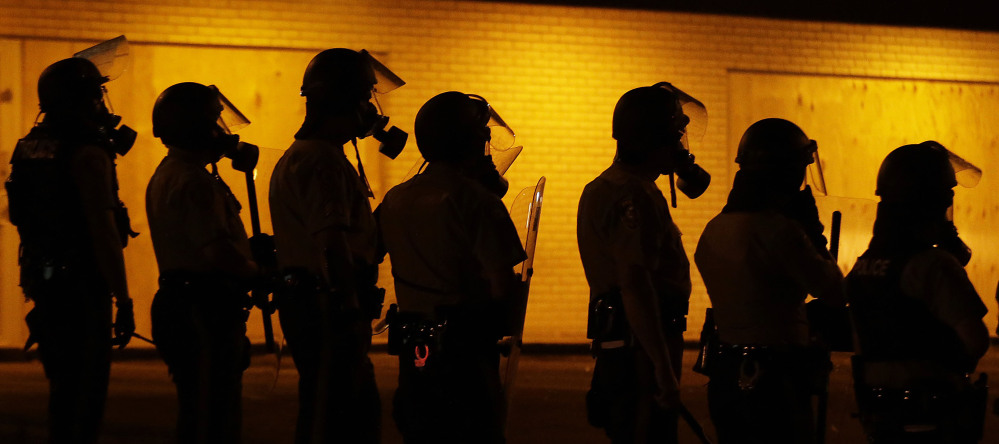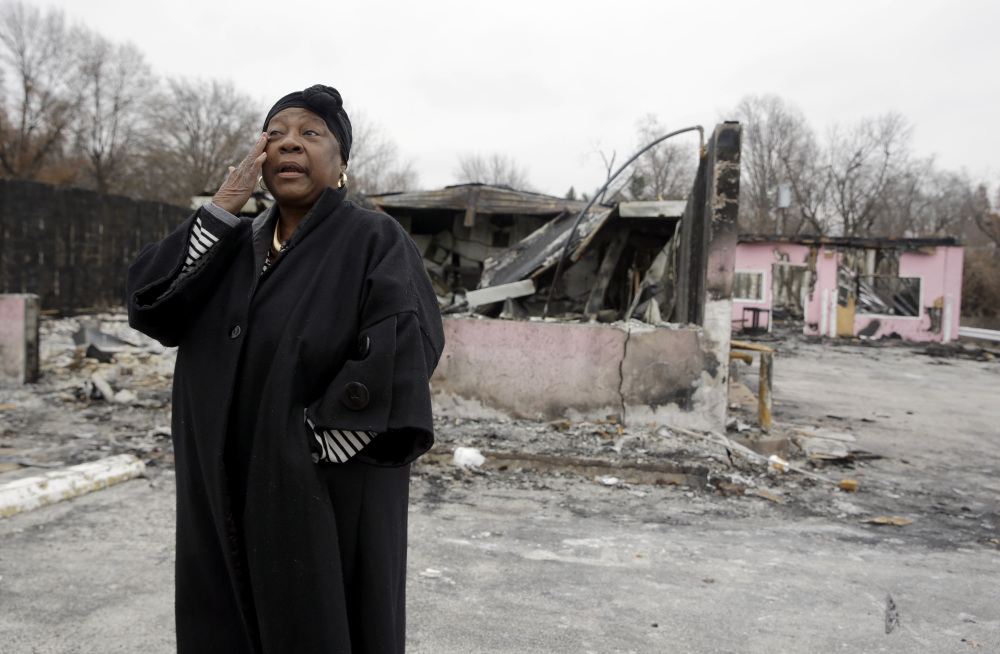FERGUSON, Mo. — Brightly colored ribbons flutter from a wrought-iron fence along the downtown business district’s main thoroughfare, snapping in the harsh winter breeze like dozens of tiny Buddhist prayer flags, each inscribed with words of inspiration: “Be kind,” “Hope and love,” “Change the world.”
Up and down South Florissant Road, paint has transformed the sheets of plywood covering windows broken during November rioting into works of art. Red hearts, white doves and peace signs in all the colors of the rainbow mingle with quotations from the Rev. Martin Luther King Jr., Chinese philosopher Lao Tzu, even the Beatles.
Messages of healing are everywhere, but the wounds in this city torn by anger are still raw and, for some, very deep.
Before this summer, few outside St. Louis County knew that Ferguson existed. That changed on Aug. 9, when white police officer Darren Wilson fatally shot Michael Brown, an unarmed black teenager. Since then, angry protesters around the country have carried signs declaring, “Ferguson is everywhere.”
To many, the name has become a byword for racial injustice, for what’s wrong with America.
“I mean, here’s my little town, and now we’re the focus of the world almost,” says Kenneth Wheat. “It’s almost like we’re set up as a model now, (of) how a community can get through something like this.”
It’s a heavy burden to place on a town of 21,000 residents. Former Mayor Brian Fletcher chooses to view it as an opportunity to determine what “our legacy truly becomes from this point forward.”
UNAWARE THERE WAS A PROBLEM
But as city officials debate reforms and business owners decide whether to rebuild torched shops, a governor’s commission is studying “the underlying social and economic conditions underscored by the unrest” after Brown’s death and a grand jury’s subsequent decision not to indict Wilson.
Meanwhile, many are waiting to see if federal officials will pursue civil rights charges in the case.
The saying goes that the first step toward recovery is acknowledging there’s a problem. But for many of the volunteers at the I Love Ferguson store across from police headquarters, the violence following Brown’s shooting and the Nov. 24 announcement that Wilson would not be charged seemed to come out of nowhere.
During his two terms as mayor, Fletcher – who helped launch the I Love Ferguson Committee this summer – says he received plenty of complaints about potholes and barking dogs. But nothing of a racial nature.
“So the part about how some people said this has been brewing for decades was surprising a little bit,” says Fletcher, who is white. “Because I never heard from any of the African-American elected officials that there were issues. If there had been something, they neglected in telling me that there was an issue.”
“It has truly been ironic that Ferguson became the forum to fight the large battle of diversity when, in fact, Ferguson is a very diverse city,” Ruffina Farrokh Anklesaria, an ethnic Indian from Trinidad and Tobago, said as she folded T-shirts for shipment. “We have more minorities here than we have whites.… It was fought in the wrong place, so to speak.”
But across town at the Canfield Green Apartments, the disaffection and anger are palpable.
Rotting flowers and Teddy bears in St. Louis Cardinals caps line the center line of Canfield Drive, where Brown’s body lay for four hours in the August sun. Along the curb, someone has spray painted the words “Hands Up Don’t Shoot” – the chant echoing at protests across the country.
The population of Ferguson is nearly 70 percent black. But at the time of Brown’s death, only three of the city’s 53 police officers were African-American.
Like many in the black community, Anthony Cage is convinced that police and firefighters allowed “the hood” parts of Ferguson to burn so they could justify bringing in the National Guard, “occupying us. Treating us like we were Russians or Cubans or somewhat, invading America.”
The 48-year-old house painter, wearing a black T-shirt with the words “Don’t Shoot” on the front and a photo of Brown on the back, says he’s been pulled over for no reason, threatened and “smacked upside the head.”
Although some whites may be in denial, he says, “it does happen. We’re not just out here saying this because we ain’t got nothing better to do.”
Kenneth Wheat isn’t saying there is no racial tension in Ferguson, only that he’d never felt it.
“To be actually honest with you, I didn’t think there was much wrong to begin with,” says the 47-year-old black father, who works as a banquet captain at a luxury hotel in St. Louis.
If anything was wrong with Ferguson, he said, it’s that the black community was not engaged enough.
Wheat has served on the Fourth of July parade committee. He and his wife, Stefannie – who is white – helped start a group for their neighborhood in Ferguson West. He’s run basketball camps and volunteered at his kids’ schools.
And at most of those gatherings, Wheat says, he’s one of the only black faces in the crowd.
After the rampage, Wheat came out with buckets of nails to help board up looted businesses. Most days, he or his 10-year-old son, Christopher, can be found at the I Love Ferguson store, making buttons or packing yard signs, coffee mugs and magnets for shipment.
“To me, it’s all about getting out of your comfort zone – getting out and just getting involved,” he says.
CHANGES AND RECOMMENDATIONS
When he asks residents why they’re demonstrating, Mayor James W. Knowles III says, “A lot of times, it has nothing to do with things that we can address in the city of Ferguson.”
One area in which most agree the city can and must improve: Police relations.
Since the shooting, the police have begun using body and dashboard cameras. The council has started the process of establishing a citizen review board and is increasing monetary incentives to encourage officers to live in the city.
Councilors have established a scholarship to help minority recruits pay for police academy training, something the city had abandoned in the past. The police department is also working with the Ferguson-Florissant School District to establish an Explorer program to create “a bullpen that we can hopefully recruit from, get people interested in law enforcement.”
George Taylor, 17, presented some recommendations to police from the Ferguson Youth Initiative Teen Summit. Among them: Get out of your cruisers and talk to us.
“Walk neighborhoods sometimes to get to know youths,” the black teen said in a low voice.
The youth group also acknowledged that teens needed to do better. Improve their behavior; make better first impressions.
“Youth need to respond to police respectfully,” he said. “Has to go both ways.”
A refrain heard over and over around town is that the worst of the rioting and damage was the work of outsiders.
True, only a dozen of the more than 200 people arrested in connection with the unrest live in Ferguson proper. But according to a list compiled by St. Louis County Justice Services, more than 80 percent were from nearby communities.
None of that makes a lick of difference to Juanita Morris. Up until Nov. 24, Juanita’s Fashions R Boutique was a thriving business for 28 years. By dawn the next day, it was a burned-out shell.
Surveying the damage on a cold morning in December, Morris pointed to the places where her office and alteration shop once stood.
The rioters who torched Morris’ shop had strayed a couple of blocks beyond the Ferguson city limits and into the even smaller town of Dellwood. Such is the indiscriminate nature of rage. But amid the ashes of her life’s work, Morris has found reason to hope.
The day after the riots, she launched a crowd-funding website. More than $22,000 in donations have poured in from around the country. Morris plans to rebuild on the same spot.
“This whole area has been damaged. So this whole area will become new – a greater area, and a better area.”
Send questions/comments to the editors.




Success. Please wait for the page to reload. If the page does not reload within 5 seconds, please refresh the page.
Enter your email and password to access comments.
Hi, to comment on stories you must . This profile is in addition to your subscription and website login.
Already have a commenting profile? .
Invalid username/password.
Please check your email to confirm and complete your registration.
Only subscribers are eligible to post comments. Please subscribe or login first for digital access. Here’s why.
Use the form below to reset your password. When you've submitted your account email, we will send an email with a reset code.